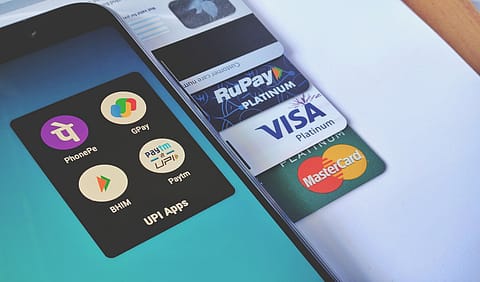650 million transactions a day and counting: UPI outpaces Visa, but who will cash in?
In May alone, UPI handled ₹25.14 lakh crore in value–about 12 times the combined value of all card payments in the country

India’s Unified Payments Interface (UPI) has now outpaced Visa to become the world’s foremost real‑time payment system, handling more than 650 million transactions a day.
Celebrating the landmark achievement, former NITI Aayog CEO and ex-Sherpa India's G20, Amitabh Kant, took to X to highlight that reaching this scale in nine years is “unmatched,” underscoring UPI’s momentum in redefining digital payments in India and across the world.
In fiscal year 2024, Visa processed an average of 639 million daily transactions on its network, according to its annual report.
Launched in April 2016 by the National Payments Corporation of India under the supervision of the Reserve Bank of India, UPI has evolved from a simple payment rail into the foundational layer of India’s digital economy.
UPI supported 83.7% of all digital transactions in India in FY25, up from 79.7% the year before. It now powers nearly 80% of the country’s digital payment volume. It enabled 185.8 billion transactions in FY25, a 41% increase from the year before, translating into a global real‑time payment market share of 48.5% by volume, according to the RBI annual report of FY25. This digital payments revolution reflects India’s broader fintech transformation: in May alone, UPI handled ₹25.14 lakh crore in value–about 12 times the combined value of all card payments in the country.
UPI’s ecosystem, spanning apps such as Google Pay, PhonePe, Paytm, and countless bank-backed platforms, is interoperable, low-cost, and accessible even in remote regions. Features such as QR‑based payments, recurring mandates, credit overlays (UPI Credit), and UPI Lite further drive its adoption and daily volume.
Likely outperformers
Recommended Stories
Karthick Jonagadla, smallcase Manager and Founder at Quantace Research, highlights several potential winners in the evolving digital payments space. “One 97 Communications (Paytm) still derives over 50% of its revenue from payments. Its wallet infrastructure earns a 1.1% merchant discount rate (MDR) on transactions above ₹2,000, and it stands to gain an additional 1.2% interchange since Credit Line on UPI went live on October 16, 2024,” he explains.
He adds that Infibeam Avenues, which operates the CCAvenue gateway, is well-positioned, too. “Since the bulk of its revenues come from payment gateway services, every additional basis point of MDR or any new corridor—such as the Gulf Cooperation Council (GCC) expansion—flows directly into its margins.”
Fino Payments Bank is another player to watch, says Jonagadla. “With a strong focus on rural micro-merchants, it’s significantly impacted by the 0.15% government subsidy on UPI person-to-merchant (P2M) payments below ₹2,000, which affects its P&L more than others.”
Yes Bank, he notes, has the largest share of merchant-side UPI traffic. “Revenue from escrow and API fees, along with the anticipated credit-line interchange, make up a more meaningful portion of its non-interest income compared to larger peers.”
Finally, Jonagadla points to Route Mobile and Tanla Platforms, key players in the CPaaS (communications platform as a service) segment. “These firms power OTP and risk-related APIs. A year-on-year surge of over 40% in UPI volumes directly translates into higher application-to-person (A2P) messaging traffic for them.”
Where are the giants?
As HDFC, ICICI, Infosys, and TCS have highly diversified fee streams, the impact of UPI is minimal, perhaps only a few basis points, says Jonagadla. "In contrast, the companies discussed earlier are far more dependent on payment volumes. For them, new MDRs, the upcoming credit-line interchange, and the ₹1,500-crore government subsidy on small-ticket UPI transactions can meaningfully boost their earnings—and consequently, their stock valuations."
Jonagadla adds, “The real upside lies in wallet rails, embedded credit lines, and subsidy-linked flows, (and) not in pure-play, zero-fee debit UPI, which benefits the larger players far less.”
Which companies will be the beneficiaries?
Cashfree Payments co-founder Reeju Datta said, "The biggest beneficiaries of UPI’s dominance are companies that operate in India and rely on seamless, high-frequency payments. These include food delivery, quick commerce, ride-hailing, gaming, and ticketing platforms. Subscription services and lending apps also stand to gain, because UPI AutoPay and instant disbursals remove layers of friction.” Even global players entering India will need to build around UPI-first experiences if they want to retain users and compete on convenience.
"Hence, the net beneficiaries would include wallet-heavy fintech acquirers, high-share settler banks that pivot fastest to credit-linked UPI, and the CPaaS vendors riding the surge in OTP traffic. Pure debit-style UPI remains a volume play; the real upside sits in credit rails + subsidy cheques," said Jonagadla.
The next growth wave
According to digital banking and payments provider NPST’s co-founder and CEO, Deepak Chand Thakur, the next wave of UPI growth will be driven by a fundamental redefinition of what constitutes a payment. "As every connected device evolves into a potential UPI touchpoint, we’ll see new use cases emerge—embedded credit, B2B transactions, IoT-enabled payments, and cross-border corridors will be key to deeper, more widespread adoption. We’re also witnessing strong momentum in underserved regions where digital infrastructure and merchant acceptance are rapidly catching up."
To keep pace, banks, fintechs, and payment aggregators must move beyond legacy infrastructure, Thakur said. "They’ll need to modernise core systems, rethink switching logic, deploy intelligent orchestration layers, and simplify offline payment operations. Real-time risk management across diverse acceptance environments will also be essential. The future hinges on how efficiently these interconnected systems communicate, adapt, and scale."
Thakur adds that transitioning to agile, opex-based models will be crucial. “Only by aligning every layer of the payments stack, across geographies, use cases, and devices, can UPI truly realise its full monetisation and inclusion potential.”
With international rollout already underway, including merchant acceptance in seven countries and plans to expand to more markets by 2028-29, UPI is truly becoming a global standard for instant payments. As Kant said, “From India to the world, UPI is leading the digital payment revolution.”